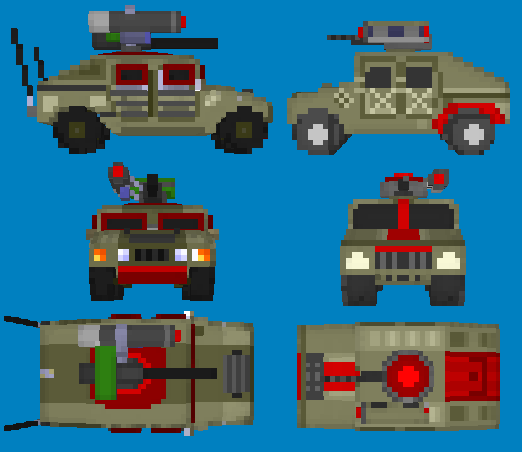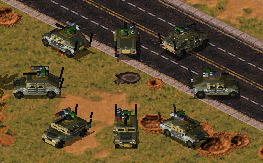

EDF Humvee:
Cost: 600
Armor: Light
Speed: Very Fast
Weapon: M312 Heavy Machinegun
Range: Medium
Weapons Factory Tech, Tier-1 Anti-Infantry Scout/Transport
The M1025/1026 Humvee is a light-recon and fast-assault vehicle that was originally produced to replace the M39 "Multigunner IFV" in US Army service during the 1980s. Designed entirely with speed in mind, the design of the Humvee has little in common with its older sibling, the M39. Rather, the design can be drawn back to the 1940s and early 1950s, when the Alliance of European Democratic Nations (the Allies) were in need of a fast all-terrain vehicle to assist in scouting and anti-infantry duties in the event of war with the Soviets. When war came in 1953, the "Ranger", which the vehicle had began to be known as in European service (called "Jeep" in the States) was heavily integrated in to the Allied armies. The vehicle's high-speed, low drag and ability to mount various weapons, ranging from 40mm automatic grenade launchers to machine guns gave the Allies several minor victories against the literal hordes of Soviet infantry divisions crossing into Germany.
These same concepts, versatility and speed, were the driving forces in the M1025 Humvee's design. Armored only to protect from small-arms, early Humvee models had single M2 Browning HMGs which were manned by a soldier who exposed himself via a gunner's hatch in the roof of the vehicle. This proved to be highly unpopular with troops, so much so that these models were completely ignored when designating the Humvee. (in reality, the Humvees used today would be the M1027, see below) The Humvee did however, offer protection for up to 3 additional fully equipped military personnel; this capability gave the Humvee another role as being a light troop transport.
The next model, the one that offially became the M1025, featured a turret ring that supported a wide range of weapons, including missile launchers, grenade launchers, repair devices, machine guns and several prototype weapons that remain classified to this day. Although the gunner still had to exit the safety of the vehicle's interior to fire, the addition of a turret-shield gave this man protection he sorely lacked in the last model. The M2 Browning remained the dominant weapon mounted to the M1025 throughout 20+ years of service with the US military, right up until the formation of the EDF.
When the EDF was formed however, the Humvee's otherwise bright future quickly clouded. There were better vehicles in the European market, so the Humvee needed to offer something that the competition couldn't. The American company General Dynamics did just this, when it made the M1026 Humvee. The M1026 Humvee retained all of the qualities of the M1025 and then some. One of the many additions was the addition of firing ports for the 3 passengers. The second was a radar uplink system, that allowed the some missile weapons to coordinate with the Humvee's basic radar package to track targets rapidly, even when the vehicle would be otherwise going too fast to maintain a lock-on. The third, and equally important, was the redesign of the weapon delivery system to allow for the gunner to control the machine gun and any other weapons mounted on the Humvee straight from his front seat.
In essence, M1026 Humvee became a military-grade drive-by vehicle, allowing for a daring driver to take his vehicle past a tank formation and literally destroy it should men with anti-armor missiles be the passengers. This made the Humvee the obvious choice for the EDF's new recon vehicle. However, in EDF service, the Humvee saw one last change- the retiring of the nearly century old M2 Browning for the new M312 Heavy Machine Gun. Although not offering much over the M2, the M312 is supposedly more reliable and efficient with its ammo.
With such astounding features, little wrong can be said about the M1026 Humvee or its concept, except for the sore lack of armor. As previously stated, the materials used to make the Humvee only provide minimal protection to just small arms. When faced up against things that use explosives of any kind, the best action a Humvee driver can take is to retreat. (it is worth noting that EDF crews have been inventive with their Humvees, welding on additional armor to key weak spots; one crew was rumored to have collected large quantities of the armor used on XT-30s and made a one inch armor plate that covered much of the vehicle with almost no effect on its speed. No official EDF reports indicate that this ever happened, as surely they would be scrambling to add this sort of immense, tank-resistant protection to all of their Humvees)
Variants:
M1025 (first version)- Largely unpopular original model of the Humvee. Only capable of mounting a machine gun.
M1025 (production version)- The US Army version, capable of using a wide variety of weapons.






